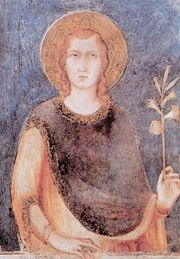Saint Emeric of Hungary
Saint Emeric of Hungary (1007 – 2 September 1031) was a Hungarian prince, the son of Stephen I, the first King of Hungary, and Queen Giselle of Bavaria. He is venerated in the Roman Catholic Church as a saint and is considered a patron saint of youth and education.
Life[edit | edit source]
Emeric was born in Esztergom, a major city of medieval Hungary, in 1007. His father, Stephen I, was the first king of Hungary, having converted the country to Christianity and established it as a Christian kingdom. Emeric was educated in a Christian spirit and was intended by his father to be his successor on the Hungarian throne. He was well-educated, showing a particular interest in the teachings of the Church and in learning about Christian doctrine.
Emeric married in 1022, but his wife's name has been lost to history. They had no children. Emeric's life was marked by his deep religious faith and his commitment to promoting Christianity in Hungary. He supported the establishment of monasteries and the spread of Christian teachings among his people.
In 1031, while hunting, Emeric was fatally wounded by a wild boar. His death was mourned by his father and the people of Hungary, who had seen in him a pious and promising future king.
Canonization and Veneration[edit | edit source]
Emeric was canonized by the Roman Catholic Church in 1083, along with his father, Stephen I, and Bishop Gerard of Csanád, by Pope Gregory VII. His feast day is celebrated on 5 November. Saint Emeric is venerated as a model of piety and chastity and is considered a patron saint of youth, particularly those seeking a religious life, and of education.
His relics are housed in various churches throughout Hungary and the world. The most significant shrine dedicated to Saint Emeric is located in the Basilica of Esztergom, where a chapel bears his name.
Legacy[edit | edit source]
Saint Emeric's legacy is closely tied to that of his father, Stephen I, in establishing Hungary as a Christian kingdom and integrating it into Christian Europe. His life and work are seen as a continuation of his father's mission, promoting Christian values and education among the Hungarian people.
The figure of Saint Emeric stands as a symbol of youthful dedication to faith and duty. His veneration reflects the importance of youth in the Church and the potential for young people to lead lives of holiness and service.
Search WikiMD
Ad.Tired of being Overweight? Try W8MD's physician weight loss program.
Semaglutide (Ozempic / Wegovy and Tirzepatide (Mounjaro / Zepbound) available.
Advertise on WikiMD
|
WikiMD's Wellness Encyclopedia |
| Let Food Be Thy Medicine Medicine Thy Food - Hippocrates |
Translate this page: - East Asian
中文,
日本,
한국어,
South Asian
हिन्दी,
தமிழ்,
తెలుగు,
Urdu,
ಕನ್ನಡ,
Southeast Asian
Indonesian,
Vietnamese,
Thai,
မြန်မာဘာသာ,
বাংলা
European
español,
Deutsch,
français,
Greek,
português do Brasil,
polski,
română,
русский,
Nederlands,
norsk,
svenska,
suomi,
Italian
Middle Eastern & African
عربى,
Turkish,
Persian,
Hebrew,
Afrikaans,
isiZulu,
Kiswahili,
Other
Bulgarian,
Hungarian,
Czech,
Swedish,
മലയാളം,
मराठी,
ਪੰਜਾਬੀ,
ગુજરાતી,
Portuguese,
Ukrainian
Medical Disclaimer: WikiMD is not a substitute for professional medical advice. The information on WikiMD is provided as an information resource only, may be incorrect, outdated or misleading, and is not to be used or relied on for any diagnostic or treatment purposes. Please consult your health care provider before making any healthcare decisions or for guidance about a specific medical condition. WikiMD expressly disclaims responsibility, and shall have no liability, for any damages, loss, injury, or liability whatsoever suffered as a result of your reliance on the information contained in this site. By visiting this site you agree to the foregoing terms and conditions, which may from time to time be changed or supplemented by WikiMD. If you do not agree to the foregoing terms and conditions, you should not enter or use this site. See full disclaimer.
Credits:Most images are courtesy of Wikimedia commons, and templates Wikipedia, licensed under CC BY SA or similar.
Contributors: Prab R. Tumpati, MD

